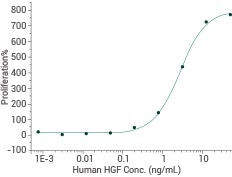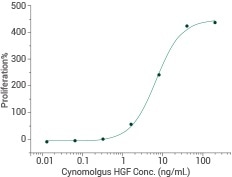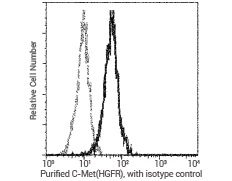Mesenchymal-epithelial transition factor (MET), also called c-Met or Hepatocyte growth factor receptor (HGFR), is a receptor tyrosine kinase (RTK) mutated or overexpressed in several malignancies. Aberrantly active MET induces angiogenesis, tumor growth and cancer metastasis. Also, MET activity is crucial to embryogenesis.
HGF, also called scatter factor (SF), is the only well-known ligand of MET. When it is activated, MET engages with a range of signal transducers at its intracellular multisubstrate docking site to stimulate Ras/MAPK, SRC, JAK/STAT, PI3K/AKT, Wnt/β-catenin and other signaling pathways.
MET and its related signaling pathways are considered to be clinically significant therapeutic targets. Several small-molecule inhibitors and antibodies targeting MET and HGF are being made as promising therapeutics for autism, heart disease, cancer and other diseases. Sino Biological has come up with high-quality reagents to aid the study of MET signaling.
c-MET and HGF proteins
A series of high activity c-MET proteins and HGF proteins has been developed by Sino Biological. These proteins are obtained from several species to help study the biology of MET signaling.

Human c-MET Protein — 10692-H20B1. Image Credit: Sino Biological Inc.
Purity
More than 90% as determined by SDS-PAGE
Activity
- The specific activity was identified to be 10 nmol/minute/mg with MBP as substrate
- Binding ability with HGF is quantified by functional ELISA

Cynomolgus c-MET Protein — 90304-C08H. Binding ability measured by ELISA. Immobilized human HGF (Cat: 10463-HNAS) at 10 µg/mL (100 µL/well) can bind canine c-MET. The EC50 is 7 ng/mL. Image Credit: Sino Biological Inc.

Human HGF Protein — 10463-HNAS. Ability to neutralize TGF-beta mediated inhibition on Mv-1-Lu cell proliferation. The ED50 is typically 0.5–5 ng/mL. Image Credit: Sino Biological Inc.

Cynomolgus HGF Protein — 90286-CNAH. Ability to inhibit TGFβ1 activity on Mv-1-lu mink lung epithelial cells. The ED50 is typically 2–10 ng/mL. Image Credit: Sino Biological Inc.
Recommended c-MET and HGF proteins
Source: Sino Biological Inc.
| Catalog # |
Species |
Molecule |
Tag |
Expressed Host |
Activity |
| 10692-H20B1 |
Human |
c-MET |
N-GST & His |
Insect Cells |
Active |
| 50622-M02H |
Mouse |
c-MET |
C-human IgG1-Fc |
HEK293 Cells |
Active |
| 50622-M08H |
Mouse |
c-MET |
C-His |
HEK293 Cells |
Active |
| 70008-D08H |
Canine |
c-MET |
C-His |
HEK293 Cells |
Active |
| 80004-R02H |
Rat |
c-MET |
C-human IgG1-Fc |
HEK293 Cells |
Active |
| 90304-C02H |
Cynomolgus, Rhesus |
c-MET |
C-human IgG1-Fc |
HEK293 Cells |
Active |
| 90304-C08H |
Cynomolgus, Rhesus |
c-MET |
C-His |
HEK293 Cells |
Active |
| 90304-CCCH |
Cynomolgus, Rhesus |
c-MET |
C-cleavage |
HEK293 Cells |
Active |
| 10463-HNAS |
Human |
HGF |
Native |
CHO Cells |
Active |
| 50038-M08H |
Mouse |
HGF |
C-His |
HEK293 Cells |
Active |
| 50038-MNAH |
Mouse |
HGF |
Native |
HEK293 Cells |
Active |
| 70063-DNAH |
Canine |
HGF |
Native |
HEK293 Cells |
|
| 80429-RNAH |
Rat |
HGF |
Native |
HEK293 Cells |
Active |
| 90286-CNAH |
Cynomolgus |
HGF |
Native |
HEK293 Cells |
Active |
Anti-c-MET and Anti-HGF antibodies
Sino Biological has come up with an extensive panel of antibodies that target HGF and MET. The antibodies can be utilized in FCM, ELISA, WB, IHC, as well as neutralization. Also, it comes with ELISA kits and ELISA pair sets.

Cell Proliferation was Inhibited by Human HGF Antibody — 10463-mh010. Proliferation of U87 MG cells elicited by autocrine HGF was inhibited by increasing concentrations of Human HGF Neutralizing Monoclonal Antibody. The IC50 is typically 1–4 µg/mL. Image Credit: Sino Biological Inc.

Flow Cytometric Analysis of Human c-Met Expression on HepG2 Cells — 10692-R243. Cells were stained with purified anti-Human c-Met, second antibody conjugated with FITC. Image Credit: Sino Biological Inc.
More antibodies of c-MET and HGF
- Anti-HGF Antibodies
- Anti-c-MET Antibodies